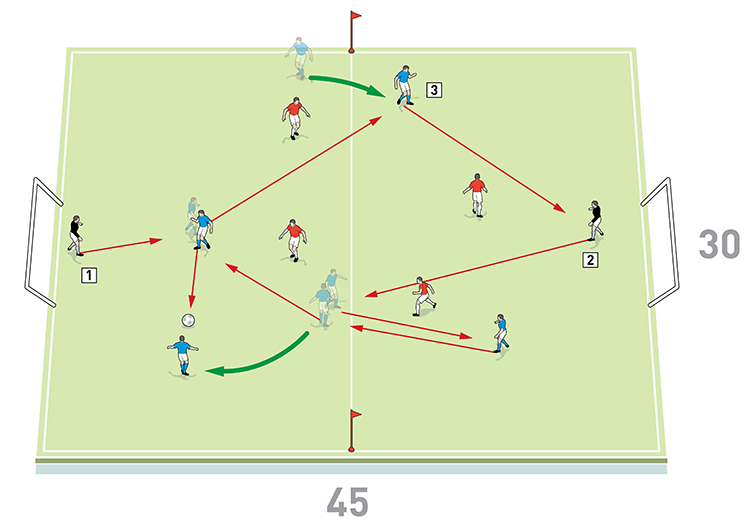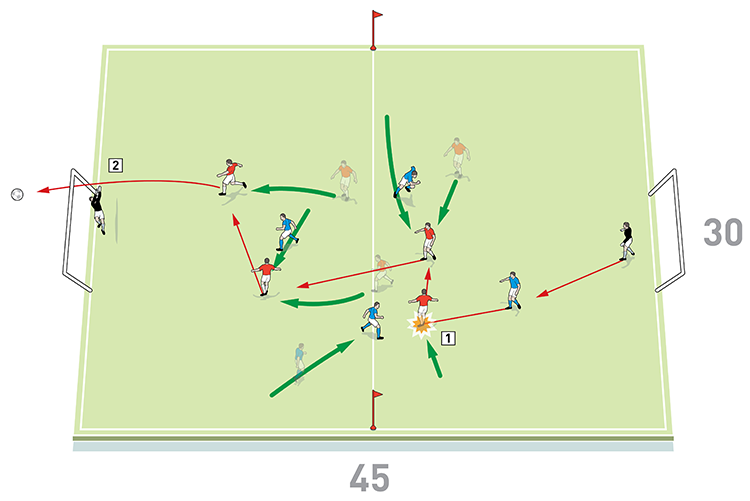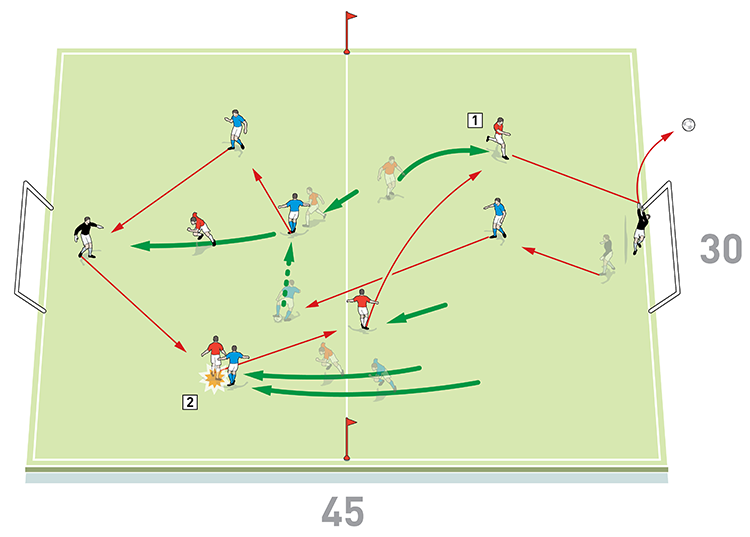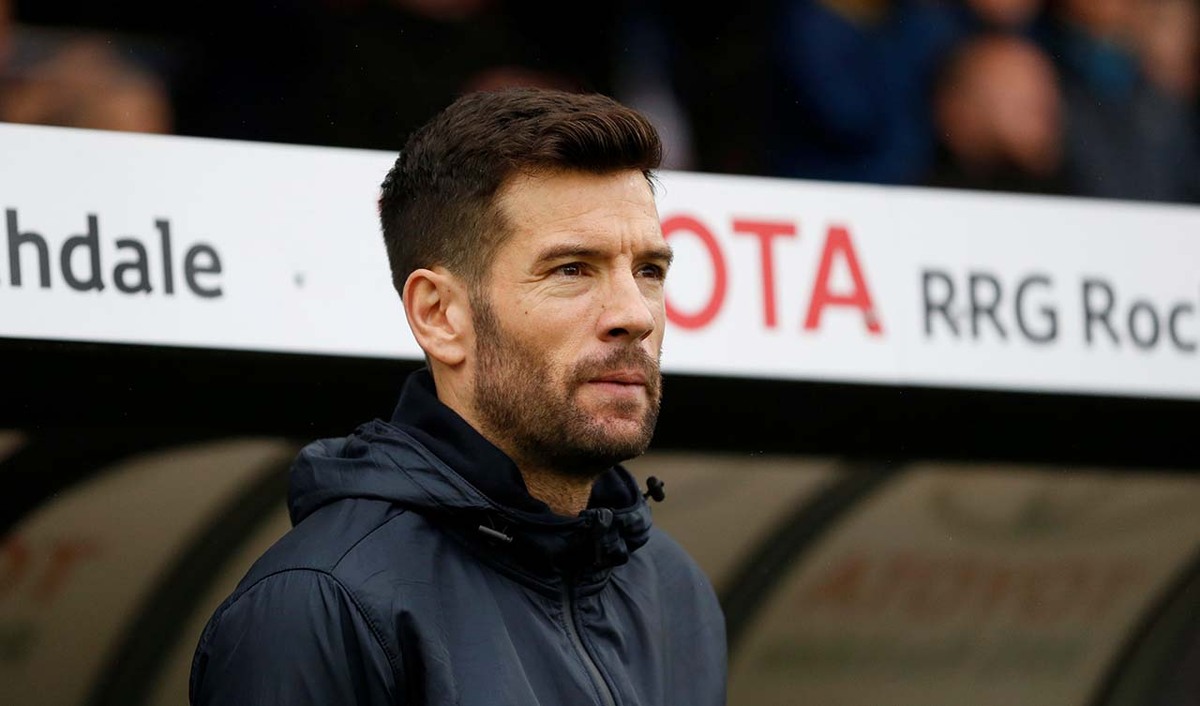You are viewing 1 of your 1 free articles
Counter-attack v possession play
This is a small-sided game working on the principles of counter-attacking and keeping possession. With one team looking to keep the ball for a set number of passes, and the other team looking to regain the ball and counter-attack in the opposite half of the pitch, it presents players with live problems and decisions to make both when in and out of possession. The score line also presents different scenarios that give the players the chance to come up with strategies to react.
| Area | 45x30 yards |
| Equipment | Balls, bibs, cones, poles, 2 goals |
| No. of Players | 8 players + 2 goalkeepers |
| Session Time | 15 mins |
This is a small-sided game working on the principles of counter-attacking and keeping possession. With one team looking to keep the ball for a set number of passes, and the other team looking to regain the ball and counter-attack in the opposite half of the pitch, it presents players with live problems and decisions to make both when in and out of possession. The score line also presents different scenarios that give the players the chance to come up with strategies to react.
We would use this session at Rochdale on days when the players are able to train at full intensity and when we are looking for high intensity running in terms of physical loads.
What do I get the players to do?
Counter v keep ball
We set up a playing area of 45x30 yards with a goal and a goalkeeper at each end. We would clearly mark a halfway line with poles and flat markers as a visual reference for the players. The number of players, the pitch size and the timings can vary depending on the physical outcomes desired by the coaching staff but here we are using eight outfield players divided into two teams of four plus keepers.
Play starts and restarts with a pass from one of the keepers to the blue passing team. The blues must pass the ball to keep hold of possession and they can use the help of both goalkeepers to create an overload in their favour. They score a point if they manage to make eight uninterrupted passes, as shown [1a].
1a

2. The blues can use the help of both goalkeepers to give them a 6v4 overload in their favour
3. The blues score a point if they manage to make eight uninterrupted passes
The other team (the reds) can score in both goals. They press to gain possession and if they succeed, they must attack the goal in the opposite half of the pitch to the one where they gained the ball, as shown [1b].
1b

2. If they win possession, the reds must attack the goal in the half opposite to the one where they gained the ball
Offsides count when crossing the halfway line so players must be in the half where the ball is to definitely be onside, unless there are also defenders in the opposite half.
We would usually play four to six games, so each team gets more than one turn in each role. We keep a note of the aggregate scores to keep it competitive.
How do I progress the activity?
This activity is normally used as the match element of our session, so the rules and restrictions are not changed too much during it. We feel that rather than needing to progress the practice, the scenarios will give the players the necessary challenges.
What are the key things to look out for?
For the team keeping possession, we want to see good supporting movements to keep the area as big as possible and to enable players to be in a position to receive the ball comfortably. They should also react fast to losing the ball and quickly transition into pressing and defending the goals.
For the team looking to counter-attack, the key decision to be made is whether to counter quickly or patiently build an attack. If they are winning the game, they may decide to just keep possession. When out of possession, this team needs to press hard in order to stop the opponents achieving their target of making eight passes [1c].
1c

2. Depending on the score, the reds must decide whether to counter immediately on winning the ball or patiently build an attack. Here they win the ball and launch a quick counter-attack
What are the typical mistakes players might make and how do I avoid them?
Players may try to counter-attack when the other team are already in their shape and it may be better to build an attack patiently. They may also rush attacks when they have a lead and they could run the clock down by keeping possession.
Related Files
Editor's Picks
Deep runs in the final third
Using the goalkeeper in build-up play
Pressing principles
Intensive boxes drill with goals
Penetrating the final third
Creating and finishing
My philosophy
Pressing initiation
Compact team movement
Coaches' Testimonials

Alan Pardew

Arsène Wenger

Brendan Rodgers

Carlos Carvalhal

José Mourinho

Jürgen Klopp

Pep Guardiola

Roy Hodgson

Sir Alex Ferguson

Steven Gerrard
Coaches' Testimonials

Gerald Kearney, Downtown Las Vegas Soccer Club

Paul Butler, Florida, USA

Rick Shields, Springboro, USA

Tony Green, Pierrefonds Titans, Quebec, Canada
Join the world's leading coaches and managers and discover for yourself one of the best kept secrets in coaching. No other training tool on the planet is written or read by the calibre of names you’ll find in Elite Soccer.
In a recent survey 92% of subscribers said Elite Soccer makes them more confident, 89% said it makes them a more effective coach and 91% said it makes them more inspired.
Get Monthly Inspiration
All the latest techniques and approaches
Since 2010 Elite Soccer has given subscribers exclusive insight into the training ground practices of the world’s best coaches. Published in partnership with the League Managers Association we have unparalleled access to the leading lights in the English leagues, as well as a host of international managers.
Elite Soccer exclusively features sessions written by the coaches themselves. There are no observed sessions and no sessions “in the style of”, just first-hand advice delivered direct to you from the coach.









